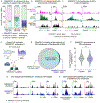The BAF chromatin complex component SMARCC1 does not mediate GLI transcriptional repression of Hedgehog target genes in limb buds
- PMID: 37805104
- PMCID: PMC11610522
- DOI: 10.1016/j.ydbio.2023.10.001
The BAF chromatin complex component SMARCC1 does not mediate GLI transcriptional repression of Hedgehog target genes in limb buds
Abstract
Transcriptional responses to the Hedgehog (HH) signaling pathway are primarily modulated by GLI repression in the mouse limb. Previous studies suggested a role for the BAF chromatin remodeling complex in mediating GLI repression. Consistent with this possibility, the core BAF complex protein SMARCC1 is present at most active limb enhancers including the majority of GLI enhancers. However, in contrast to GLI repression which reduces chromatin accessibility, SMARCC1 maintains chromatin accessibility at most enhancers, including those bound by GLI. Moreover, SMARCC1 binding at GLI-regulated enhancers occurs independently of GLI3. Consistent with previous studies, some individual GLI target genes are mis-regulated in Smarcc1 conditional knockouts, though most GLI target genes are unaffected. Moreover, SMARCC1 is not necessary for mediating constitutive GLI repression in HH mutant limb buds. We conclude that SMARCC1 does not mediate GLI3 repression, which we propose utilizes alternative chromatin remodeling complexes.
Keywords: BAF; GLI3; Hedgehog; Limb bud; SWI/SNF; Transcriptional repression.
Copyright © 2023 Elsevier Inc. All rights reserved.
Figures




Update of
-
The BAF chromatin complex component SMARCC1 does not mediate GLI transcriptional repression of Hedgehog target genes in limb buds.bioRxiv [Preprint]. 2023 Jul 17:2023.02.03.527038. doi: 10.1101/2023.02.03.527038. bioRxiv. 2023. Update in: Dev Biol. 2023 Dec;504:128-136. doi: 10.1016/j.ydbio.2023.10.001. PMID: 36798239 Free PMC article. Updated. Preprint.
References
Publication types
MeSH terms
Substances
Grants and funding
LinkOut - more resources
Full Text Sources
Molecular Biology Databases

